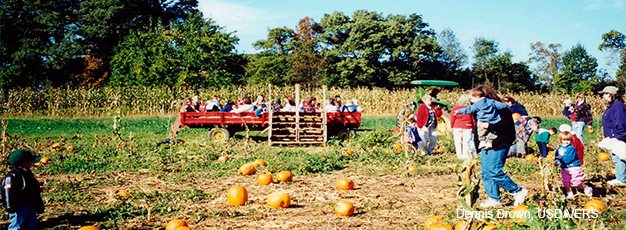Agritourism Offers Opportunities For Farm Operators

In 2004, approximately 52,000 U.S. farms—2.5 percent of all farms—received income from farm-based recreation, totaling about $955 million. Farm-based recreation, or agritourism, refers to a wide variety of onfarm recreational and entertainment-related activities, including hunting, fishing, petting zoos, horseback riding, and onfarm rodeos. As farmers look for alternative sources of income, farm recreation may expand to play a more important role in the future.
Onfarm recreation offers several potential benefits to farm operators. It can help supplement income from farm production activities while providing an opportunity to more fully employ assets, including farm household members. It can also help diversify a farmer’s income stream, serving as a potential cushion against farm income fluctuations due to variability in weather, prices, and government payments.
According to USDA’s 2004 Agricultural Resource Management Survey (ARMS), the South accounts for more than half of all U.S. farms receiving recreational income. The Midwest accounts for about a quarter. Recreational farm operations also are more likely to be in nonmetropolitan counties and in areas more dependent on recreation in general.
ARMS data suggest that activities such as horseback riding and dude ranches seem to be popular among recreation customers, with nearly 60 percent of recreation farms specializing in raising cattle and calves or horses, ponies, and mules. Of farms involved in recreation, the largest farms—those with at least 1,000 acres—have the highest per farm median recreational income, $4,000 (see chart on page 39). Medium-sized farms—those with 250-999 acres—have the smallest recreational income at $2,500 per farm. Among all farms reporting recreational income, the median farm size is quite large—about 3,100 acres.
A recent ERS study found that both farm-based and place-based factors are associated with farm-to-farm variation in agritourism. Among farm-based factors, operator net worth is positively associated with variation in farm recreation business involvement, as well as with the amount of income received by the farmer involved in recreation. Additionally, farmers who work more hours in nonfarm activities during the summer are less likely to be involved in onfarm recreation businesses.
Among place-based variables, the greater the farm’s distance to a city of at least 10,000 population, the greater the likelihood of the farm’s participation in a recreation business. A county’s endowments of natural amenities (water area, climate, and topography) also are significantly related to farm involvement in recreation, while a county’s level of overall recreation activity (farm and nonfarm) is significantly related to income derived from farm recreation.
Farm-Based Recreation: A Statistical Profile, by Dennis Brown and Richard Reeder, USDA, Economic Research Service, December 2007


